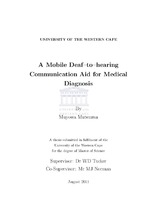| dc.description.abstract | Many South African Deaf people use their mobile phones for communication with SMSs yet they would prefer to converse in South African Sign Language. Deaf people with a capital `D' are different from deaf or hard of hearing as they primarily use sign language to communicate. This study explores how to design and evaluate a prototype that will allow a Deaf person using SASL to tell a hearing doctor how s/he is feeling and provide a way for the doctor to respond. A computer{based prototype was designed and evaluated with the Deaf people in a previous study. Results from the user trial of the computer{based mock{up indicated that Deaf users would like to see the prototype on a cell phone. Those user trial results, combined with our own user survey results conducted with Deaf people, are used as requirements. We built a prototype for a mobile phone browser by embedding SASL videos inside XHTML pages using Adobe Flash. The prototype asks medical questions using SASL videos. These questions are arranged in an organized way that helps in identifying a medical problem. The answers to the questions are then displayed in English and shown to the doctor on the phone. A content authoring tool was also designed and implemented. The content authoring tool is used for populating the prototype in a context free manner allowing for plug and play scenarios such as a doctor's office, Department of Home A airs or police station. A focus group consisting of Deaf people was conducted to help in the design and pilot trial of the system. A final user trial was conducted with more than thirty Deaf people and the results are presented and analyzed. Data is collected with questionnaires, semi-structured interviews and video recordings. The results indicate that most of the Deaf people found the system easy to learn, easy to navigate through, did not get lost and understood the sign language in the videos on the mobile phone. The hand gestures and facial expressions on the sign language videos were clear. Most of them indicated they would like to use the system for free, and that the system did not ask too many questions. Most of them were happy with the quality of the sign language videos on the mobile phone and would consider using the system in real life. Finally they felt their private information was safe while using the system. Many South African Deaf people use their mobile phones for communication with SMSs yet they would prefer to converse in South African Sign Language. Deaf people with a capital `D' are different from deaf or hard of hearing as they primarily use sign language to communicate. This study explores how to design and evaluate a prototype that will allow a Deaf person using SASL to tell a hearing doctor how s/he is feeling and provide a way for the doctor to respond. A computer{based prototype was designed and evaluated with the Deaf people in a previous study. Results from the user trial of the computer{based mock{up indicated that Deaf users would like to see the prototype on a cell phone. Those user trial results, combined with our own user survey results conducted with Deaf people, are used as requirements. We built a prototype for a mobile phone browser by embedding SASL videos inside XHTML pages using Adobe Flash. The prototype asks medical questions using SASL videos. These questions are arranged in an organized way that helps in identifying a medical problem. The answers to the questions are then
displayed in English and shown to the doctor on the phone. A content authoring tool was also designed and implemented. The content authoring tool is used for populating the prototype in a context free manner allowing for plug and play scenarios such as a doctor's office, Department of Home A airs or police station. A focus group consisting of Deaf people was conducted to help in the design and pilot trial of the system. A final user trial was conducted with more than thirty Deaf people and the results are presented and analyzed. Data is collected with questionnaires, semi-structured interviews and video recordings. The results indicate that most of the Deaf people found the system easy to learn, easy to navigate through, did not get lost and understood the sign language in the videos on the mobile phone. The hand gestures and facial expressions on the sign language videos were clear. Most of them indicated they would like to use the system for free, and that the system did not ask too many questions. Most of them were happy with the quality of the sign language videos on the mobile phone and would consider using the system in real life. Finally they felt their private information was safe while using the system. | en_US |

